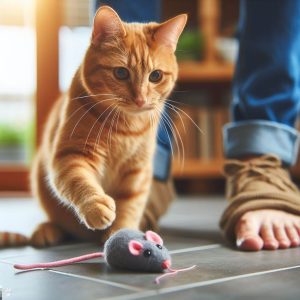Is your feline friend constantly sneezing and have watery eyes? It can be worrying to see your cat exhibiting these symptoms. But don’t fret – watery and runny eyes accompanied by sneezing in cats can often be easily treated.
Cats can develop watery eyes (also known as epiphora) and sneeze for a number of reasons. In most cases, it is a minor issue that can be managed with some basic care and treatment at home. However, persistent watery eyes and sneezing in cats can also indicate more serious underlying health conditions that require veterinary attention.
Here are the 7 most common causes for watery eyes and sneezing in cats and tips on how to treat it:
1. Allergies
Allergies are one of the most common causes of watery eyes and repetitive sneezing in cats. Just like humans, cats can develop allergic reactions to certain substances in their environment such as:
- Pollen
- Dust mites
- Mold
- Cleaning products
- Perfumes
- Cigarette smoke
- Certain foods (e.g. beef, dairy products)
The allergens cause the cat’s immune system to overreact, triggering inflammation of the nasal passages, throat, and eyes. This results in watery ocular and nasal discharge, itchy eyes, congestion, and sneezing fits.
Treatment for Allergies:
- Keep the cat away from potential allergens to minimize exposure. Use air purifiers and vacuum regularly.
- Antihistamines like diphenhydramine can help control allergy symptoms. Consult your vet for dosage.
- Immune-modulating medications like cyclosporine may be prescribed for severe seasonal or perennial allergies.
- Allergen-specific immunotherapy (allergy shots) can potentially decrease sensitivity over time.
2. Upper Respiratory Infection
Upper respiratory infections (URIs) are common in cats and can cause similar symptoms as allergies. The most common pathogens responsible for URIs in cats include:
- Feline herpesvirus
- Feline calicivirus
- Chlamydophila felis
- Bordetella bronchiseptica
These viruses, bacteria, or a combination can infect the nasal passages, throat, and upper airways. Inflammation follows, leading to discharge from eyes and nose, ulcers in mouth, fever, loss of appetite, and sneezing.
URIs tend to be highly contagious between cats, spreading through direct contact or shared dishes/linens. Stress, crowded conditions, and lowered immunity also increase susceptibility.
Treatment for Upper Respiratory Infections:
- Antibiotics prescribed by a vet to fight secondary bacterial infections.
- Antiviral medications if the underlying cause is a virus, such as lysine supplements for herpesviruses.
- Medications to reduce fever, congestion, or eye inflammation.
- Keep the cat isolated until symptoms resolve to prevent spread.
- Boost immunity by reducing stress and feeding a nutritious diet.
3. Feline Calicivirus
Among the varied causes of URIs, feline calicivirus (FCV) alone can also lead to ocular discharge and sneezing in cats. The highly contagious virus causes ulcerations and inflammation of the mouth, nose, throat, and eyes.
Infected cats develop watery, mucus-laden discharge from the eyes, sneezing, coughing, ulcers on tongue/lips, fever, lethargy, and reduced appetite. In some cases, lameness and limb pain may also occur. The virus is easily spread between cats through saliva and nasal secretions.
Treatment for Feline Calicivirus:
- There is no specific cure for FCV – treatment focuses on supporting care and resolving symptoms.
- Antibiotics for secondary infections. Anti-inflammatories and pain medication for ulcers.
- Antiviral lysine supplements may help restrict viral replication during active infection.
- Isolate affected cats until a week after symptoms resolve. Disinfect bowls, litter boxes, and bedding to eliminate virus.
- FCV vaccine part of core vaccination schedule to prevent infection. But efficacy varies due to virus mutations.
4. Feline Herpesvirus Infection
Like FCV, feline herpesvirus (FHV-1) is another major viral culprit of upper respiratory disease in cats. The highly contagious virus spreads through ocular and nasal secretions of infected cats.
Common symptoms associated with FHV-1 include:
- Ocular discharge – typically thick and yellowish.
- Red, watery eyes.
- Sneezing fits.
- Nasal congestion.
- Ulcers on tongue and nose.
- Loss of appetite.
- Lethargy.
Once infected, the virus remains dormant in the nerves and reactivates periodically when immunity is low. Stress is a major trigger for recurrence.
Treatment for Feline Herpesvirus:
- Unfortunately FHV-1 has no cure since it remains latent for life. Treatment focuses on managing symptoms.
- Antiviral medications like famciclovir may be prescribed to control outbreaks. Lysine helps inhibit virus replication.
- Keep eyes lubricated with artificial tear ointments to prevent corneal damage.
- Reduce stress and maintain proper nutrition to boost immunity against recurrences.
- Isolate cat during active infection to limit spread to other pets. Disinfect environment.
- Vaccination helps prevent severity although not foolproof due to viral mutations.
5. Primary or Secondary Bacterial Infection
While upper respiratory viruses damage the protective barriers in a cat’s eyes and nasal passages, it can open the door for opportunistic bacterial infections.
- Chlamydophila felis and Bordetella bronchiseptica are two common bacterial agents of upper respiratory disease.
- They either cause primary infections or secondary infections following viral damage to respiratory tissues.
- Infected cats typically develop thick, discolored (often yellow-green) eye discharge along with sneezing, nasal discharge, fever, and coughing.
Treatment for Bacterial Infections:
- Antibiotic ophthalmic drops or oral medications prescribed by a vet based on bacterial culture.
- Apply warm compresses to promote drainage and soothe eye inflammation.
- Use saline nose drops to ease nasal congestion.
- Isolate cat from other pets to prevent contagion while on treatment.
- Boost immunity by reducing stress and feeding healthy diet.
6. Foreign Objects or Irritation
Sometimes watery eyes accompanied by sneezing can signal the presence of an irritant or foreign object lodged in the eye rather than infection:
- Dust, dirt, loose eyelashes, debris, or eyelid hair can get trapped in the eye and cause tearing, blinking, and discomfort.
- Allergens like pollen or certain shampoos may similarly irritate the eye.
- Smoke, perfumes, or chemical cleaners can trigger ocular and nasal irritation.
Treatment for Ocular Irritation:
- Check under eyelids and rinse eye with warm sterile saline to flush out any foreign material.
- Avoid rubbing eyes as it may worsen irritation.
- Limit exposure to irritants and allergens where possible.
- Seek prompt vet attention if irritation persists after rinsing – an embedded foreign object may require specialized removal.
7. Blocked Tear Ducts
A lesser known reason for excessive tearing or runny eyes in cats – obstruction of the tear or nasolacrimal ducts that drain fluid from the eye.
- The tear ducts can get blocked by tissue overgrowth, infection, injury or birth defects. This prevents proper tear drainage.
- Bacteria may ascend the backed up ducts into the eye and nasal passages, causing secondary infections.
- Resulting symptoms are watery eyes with overflowing tears, skin irritation of face, and sneezing due to nasal discharge.
Treatment for Blocked Tear Ducts:
- The vet will flush and attempt to unblock the nasolacrimal ducts using micro-tubes. Antibiotics may be prescribed.
- Sometimes surgical opening or placement of silicone drainage tubes in the ducts are necessary.
- Long term medication to reduce excess tear production may be required in recurrent cases.
When to See the Vet
In most instances, watery eye discharge and sneezing in cats can be treated with some TLC and home care. But if you notice any of the below, seek prompt veterinary attention:
- Eyes appear extremely red, swollen or painful
- Severe, thick, or discolored eye discharge (yellow/green)
- No improvement despite 10-14 days of treatment
- Additional symptoms like lethargy, appetite loss, or fever
- Sudden onset of facial swelling, ulcers, or nosebleed
A thorough physical exam and diagnostic tests like cultures, X-rays, or MRI will help the vet determine the underlying cause and appropriate treatment plan. Recurrent or chronic cases may require referral to a veterinary ophthalmologist for specialized care.
How to Care for Your Cat With Watery Eyes and Sneezing
While most causes of cat sneezing accompanied by watery eyes are treatable and reversible, your pet may require some extra TLC during this time to aid in recovery and make them more comfortable. Here are some tips:
Keep their eyes clean
- Use a warm, damp cloth to gently wipe away any eye discharge several times a day. This prevents crusting and removes irritants.
- Rinse with an eyewash solution prescribed by your vet. Do not use human eye drops, which may be harmful.
- Avoid rubbing the eyes which can cause further irritation.
Apply prescribed ointments/drops
- Administer any medicated eye drops or gels as directed to treat infection and reduce inflammation. This helps relieve itchy eyes.
- Apply an artificial tear ointment to lubricate dry eyes between medications. Consult your vet first.
Use a humidifier
- Dry air can aggravate sneezing and stuffy noses. Run a humidifier to add moisture back and make breathing easier.
Ensure adequate hydration
- Watery eyes and nasal discharge can result in dehydration. Make sure your cat is drinking enough purified water. Add broths or kitten milk replacer to tempt them.
Offer soft, easily chewable food
- Difficulty eating due to mouth ulcers or congestion can cause appetite loss. Offer softened kibble soaked in broths or canned pate style food.
Keep their resting area clean and soothing
- Don’t expose them to smoke, chemicals, perfumes or dust that can further irritate eyes and nose.
- Wash bedding frequently to remove allergens. Consider a hypoallergenic pillow or blanket.
- Place their bed in a quiet, dimly lit room so they can rest comfortably.
Help them relax
- Minimize stress during recovery with extra playtime, brushing, and cuddles (if they tolerate handling).
- Introduce calming aids like Feliway diffusers or calming collars/supplements. These can reduce anxiety and boost healing.
The Bottom Line
Watery eyes accompanied by sneezing is a common symptom seen in cats that can arise from multiple causes like allergies, infections, irritants, or tear duct problems. While some trial and error with treatments may be necessary, identifying the underlying trigger is key to resolving the issue and providing your cat relief.
With a combination of veterinary care, medications, and some TLC at home, most cats with watery eyes and sneezing can make a full recovery and return to their happy, healthy selves. But do consult your vet promptly if symptoms do not improve or you notice additional worrying signs. Catching and addressing the problem early is important to prevent complications and permanent damage.



